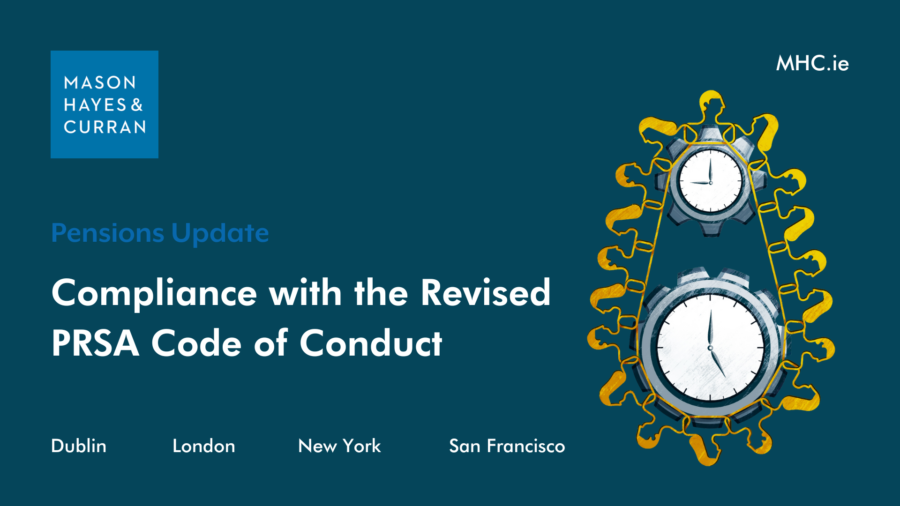Compliance with the Revised PRSA Code of Conduct
What providers need to know

The Pensions Authority has revised the Personal Retirement Savings Account (PRSA) Code of Conduct, introducing new requirements on conflicts of interest, risk warnings and product oversight. PRSA providers must ensure compliance by 1 August 2025 to adhere to regulatory expectations and safeguard PRSA contributors. Our Pensions team examines the implications for stakeholders.
What you need to know
- New Code of Conduct: The Pensions Authority has revised the PRSA Code of Conduct, effective from 1 August 2025.
- Key additions: The revised PRSA Code of Conduct includes new sections on conflicts of interest, risk warnings, and product oversight.
- Compliance obligations: PRSA providers must implement written policies and governance frameworks to meet regulatory expectations.
- Consumer protection focus: Enhanced risk warning use ensures contributors understand the implications of unregulated investments.
- Ongoing review: Providers must continuously assess and document their compliance strategies.
The Pensions Authority has published a revised Personal Retirement Savings Account (PRSA) Code of Conduct, which introduces significant changes for most PRSA providers. Under the Pensions Act, the Authority is responsible for ensuring that PRSA products are produced, marketed, and sold in a manner that protects consumers and maintains regulatory oversight. The new code will take effect on 1 August 2025, requiring PRSA providers to implement necessary changes to ensure compliance.
Key changes
The updated Code introduces three critical areas of focus:
1. Conflicts of interest
The code dictates that PRSA providers must have a written conflict of interest policy. This policy must identify the circumstances that amount to or may give rise to a conflict of interest in the production, marketing and selling of a PRSA product, which may include the facilitation of unregulated investments through a PRSA product by contributors. It must specifically indicate how conflicts are to be managed. Providers must also identify and seek to avoid potential conflicts, within their organisation as well as between the provider or contributor and any person, including:
- The provider’s directors, officers and employees
- Persons directly or indirectly linked to the PRSA provider by control, and
- Intermediaries and distributors.
The provider must disclose any unavoidable conflicts to the PRSA contributor as soon as reasonably practicable. The disclosure should include a clear explanation of the nature of the conflict and how it arises. It must also outline the risks to the contributor and the strategies in place to mitigate them.
Contributors must also acknowledge conflicts in writing before an investment, which involves a conflict of interest, may proceed. The provider must keep a record of each acknowledgement and provide copies to the Pensions Authority upon request.
2. Risk warnings
PRSA providers must provide a standardised risk warning to the contributor before facilitating investments in unregulated assets. The Code sets out the form in which a warning should take. It must highlight key risks, including the potential loss of the entire investment and the lack of protection under the Central Bank’s regulatory framework.
3. Product oversight and governance
PRSA providers, excluding life assurance companies, must identify target markets of groups of compatible PRSA contributors for each PRSA product offered. The Code sets out a number of factors to be considered when assessing the target market of a product, including:
- The characteristics, risk profile, complexity and nature of that PRSA product
- The nature of the investments which the PRSA product’s assets may be allowed to invest in
- The financial literacy, needs, characteristics and objectives of the PRSA contributors belonging to the target market, and
- The distribution strategy appropriate for that PRSA product.
The provider must also identify groups of potential contributors for whose needs, characteristics and objectives a product is not compatible. Providers must take reasonable steps to ensure that distribution strategies align with the identified target market. An annual review of the target market and distribution strategy is required to ensure ongoing suitability. The target market identification and review process must be documented and a record kept for audit purposes. Copies should be made available to the Pensions Authority upon request.
Compliance measures for PRSA providers
To meet the Code’s new requirements, PRSA providers should take the following steps:
- Review existing policies: Assess existing policies to identify gaps in conflict management, risk warning and governance.
- Develop training programmes: Educate staff on the Code’s new requirements and best practice.
- Enhance record-keeping: Introduce systems to record compliance efforts and ensure audit readiness.
- Engage with stakeholders: Communicate with distributors, intermediaries and contributors to ensure alignment with the revised code.
- Schedule regular reviews: Establish a governance framework for ongoing assessment and improvement.
Next steps
The revised PRSA Code of Conduct represents a significant step in enhancing transparency and consumer protection in the PRSA market. PRSA providers must take proactive measures to comply with the new requirements before the deadline of 1 August 2025. By implementing robust policies on conflicts of interest, risk disclosure and governance, providers can ensure regulatory alignment while safeguarding PRSA contributors’ interests. Compliance is not just a regulatory necessity- it is a commitment to ethical financial practices and consumer trust.
For more information and expert guidance, contact a member of our Pensions team.
People also ask
When does the Revised PRSA Code of Conduct come into effect? |
The revised code will take effect on 1 August 2025, requiring PRSA providers to implement necessary changes to ensure compliance. |
What are the key changes envisaged by the Revised Code? |
The revised code includes new sections on conflicts of interest, risk warnings, and product oversight. |
The content of this article is provided for information purposes only and does not constitute legal or other advice.
Share this:


